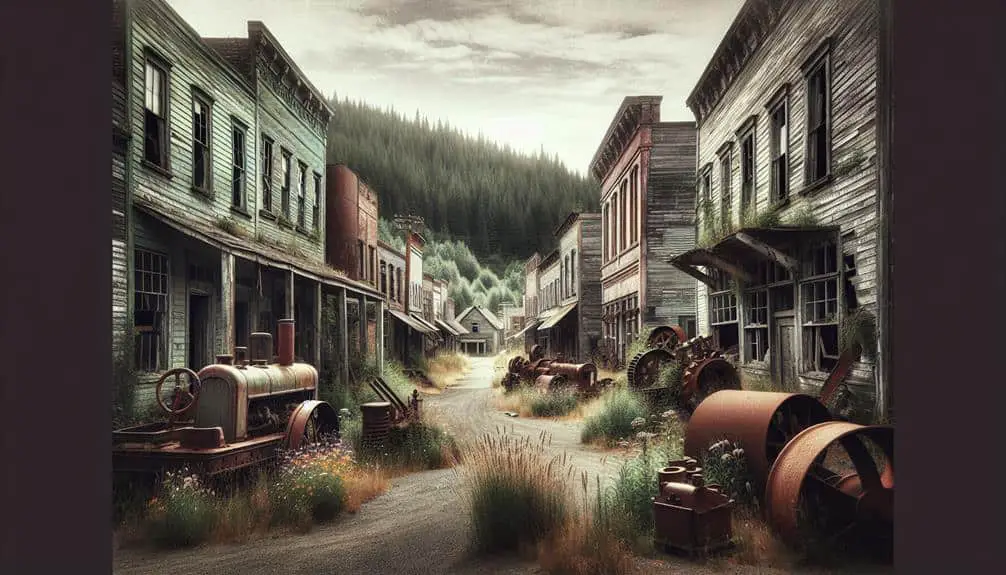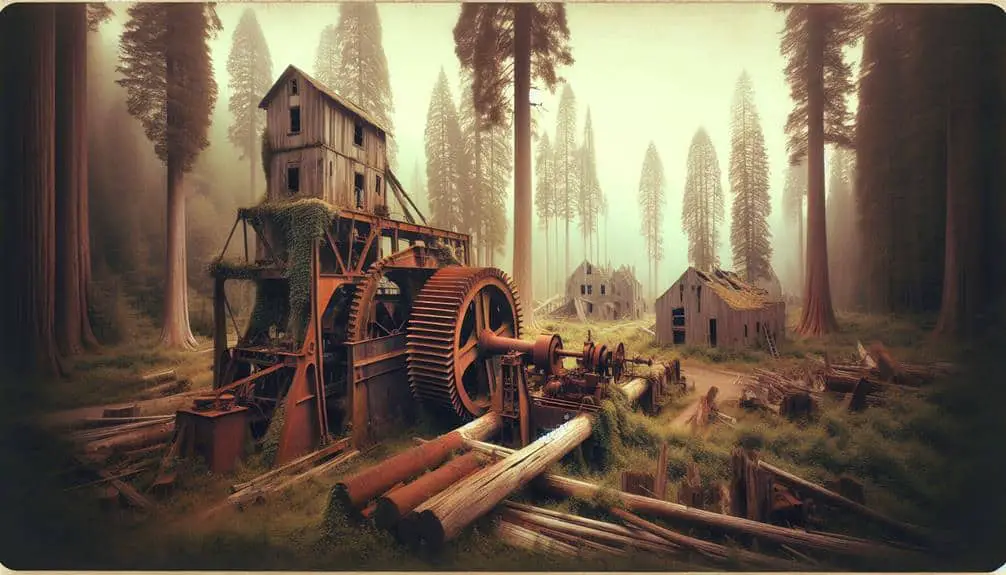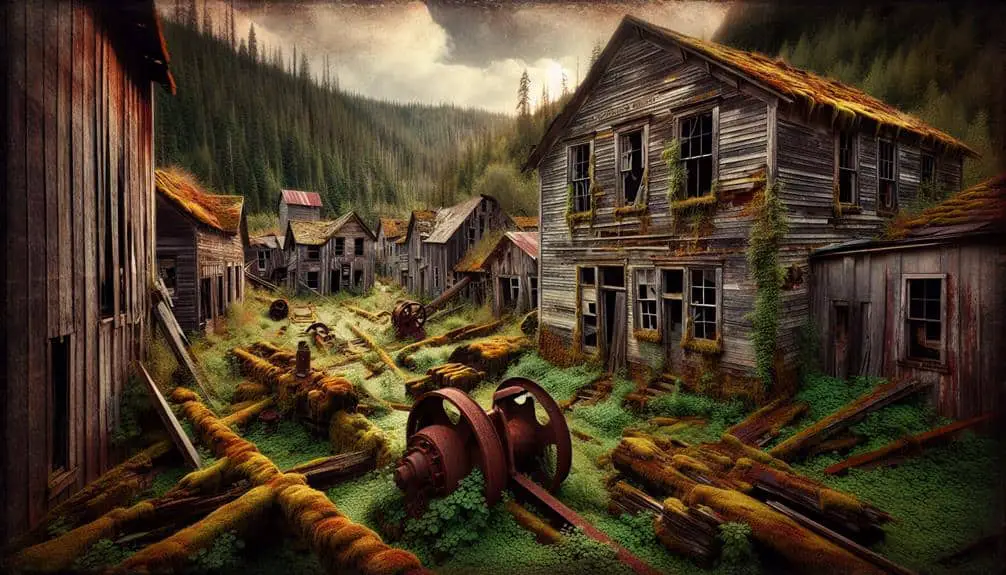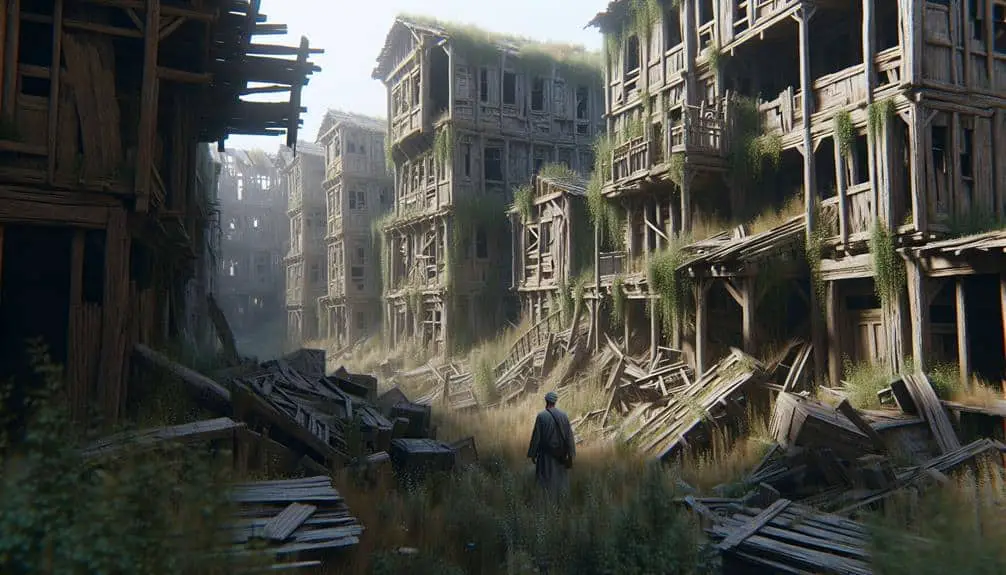Embark on a journey to discover America's past in abandoned lumber towns. You'll encounter rusted relics and weathered homes, remnants of a bygone era. The silence in these towns speaks volumes, as nature reclaims the streets once bustling with life. Tracing the footsteps of the logging industry reveals a rich history etched in landscapes. Towering trees and rusted machinery stand as silent storytellers. The haunting aura of these forgotten places invites you to witness history preserved in time. Explore further to reveal more about these forgotten towns and the legacy they hold.
Key Points
- Rusty relics and weathered homes in abandoned lumber towns tell stories of the past.
- Rugged landscapes hold remnants of once-thriving logging communities.
- Historical preservation and urban exploration uncover haunting silence in deserted towns.
- Railroad tracks and rusted machinery serve as reminders of the logging industry's legacy.
- Towering trees stand as guardians, preserving the history of abandoned lumber towns.
Rise and Fall of Sawmills
The thunderous roar of sawmills once echoed through the valleys, shaping the landscape and livelihoods of countless communities across America. Sawmill technology evolved rapidly, from manual labor to steam-powered machines that revolutionized the lumber industry trends. These sawmills were more than just structures; they were the heartbeats of towns, providing jobs and prosperity. The sound of buzzing saws and clanking machinery filled the air, a symphony of progress and productivity.
As you explore the remnants of these once-thriving sawmills, you can't help but feel a sense of awe at the ingenuity of the past. The towering stacks of timber waiting to be processed, the intricate network of conveyor belts, and the skilled workers who operated the machinery with precision—all tell a story of ambition and hard work.
In these abandoned lumber towns, nature is slowly reclaiming what was once taken. Rusting gears and decaying buildings stand as reminders of a bygone era, where sawmills stood as symbols of growth and prosperity. Despite the changes and challenges faced by the lumber industry, the legacy of sawmill technology continues to shape the forests and communities of America.
Timber Boom and Bust
During the Timber Boom and Bust period, fortunes were made and lost in the blink of an eye as the forests echoed with the relentless rhythm of progress. It was a time of rapid expansion and sudden downturns, shaping the landscape and economies of countless lumber towns across America.
Here's a glimpse into the boom and bust cycles that defined this era:
- Unprecedented Growth: Sawmills sprang up like wildfire, drawing in workers and entrepreneurs keen to capitalize on the demand for timber.
- Economic Prosperity: The timber industry fueled local economies, creating jobs and driving development in once-remote areas.
- Over-Extraction: As demand soared, forests faced unsustainable logging practices, leading to environmental degradation and resource depletion.
- Sudden Decline: When the timber supply dwindled, markets crashed, leaving behind ghost towns and abandoned mills as stark reminders of the economic impact of the Timber Boom and Bust.
Logging Industry Decline
Amidst the echoes of prosperity that once resonated through bustling lumber towns, the logging industry's decline cast a shadow over the landscape, marking a stark shift in fortunes. The once-thriving logging operations faced a multitude of challenges, leading to a significant downturn. One of the key factors contributing to this decline was the mounting concern over the environmental impact of rampant deforestation. Conservation efforts gained momentum as communities and organizations rallied to protect the dwindling forests and wildlife habitats.
Moreover, technological advancements played a pivotal role in reshaping the logging industry. The introduction of automation revolutionized the way trees were harvested, increasing efficiency but also reducing the demand for manual labor. As a result, many traditional logging communities found themselves grappling with unemployment and economic uncertainty. The hum of machinery replaced the sounds of axes and saws, forever altering the landscape and way of life in these once-thriving lumber towns.
Abandoned Mill Towns
Nestled among the overgrown foliage and crumbling structures lie the remnants of abandoned mill towns, whispering tales of a bygone industrial era. As you wander through these ghostly settlements, you can't help but feel the weight of history pressing down around you. Here's what you might encounter:
- Rusty Relics: The abandoned mills stand as silent sentinels, their once-bustling machinery now frozen in time.
- Weathered Homes: Dilapidated houses with peeling paint and broken windows speak of families long gone, leaving behind fragments of their lives.
- Overgrown Streets: Nature reclaims the land, weaving through cracked asphalt and reclaiming the once-busy thoroughfares.
- Haunting Silence: The only sound is the rustling of leaves in the wind, a stark reminder of the economic impact that swept through these towns.
Exploring these forgotten places raises questions about the importance of historical preservation and the stories waiting to be uncovered in these quiet corners of America.
Tracing Logging Towns Today
As you roam through the remnants of abandoned mill towns, your curiosity naturally extends to tracing logging towns today, where the echoes of a once-thriving industry linger amidst the towering trees and rugged landscapes. In the quest for historical preservation and urban exploration, these logging towns offer a glimpse into a bygone era, where the sound of sawmills and the shouts of lumberjacks once filled the air.
Today, these towns stand as a proof to the resilience of nature and the adaptability of communities. Walking through the streets, you can almost hear the creaking of the old timber buildings and envision the hustle and bustle of daily life in a logging town. The remnants of railroad tracks and rusted machinery serve as silent reminders of the industrious past that shaped these landscapes.
Despite the passage of time, there's a sense of timelessness in these logging towns. The towering trees that once fueled the industry now stand as guardians of the past, their silent presence adding to the mystique of these forgotten places. In tracing logging towns today, you uncover not just abandoned buildings, but stories of hardship, perseverance, and the enduring spirit of those who called these places home.
Frequently Asked Questions
How Were Abandoned Lumber Towns Typically Built and Organized in Terms of Infrastructure and Layout?
In the early days, abandoned lumber towns rose like dreams woven into reality. Urban planning and infrastructure meticulously crafted the heartbeat of these settlements. Historical preservation now breathes new life, revitalizing forgotten echoes of the past.
What Were Some Common Challenges or Obstacles Faced by Residents Living in These Abandoned Lumber Towns?
Living in abandoned lumber towns brought unique challenges. Social dynamics often strained due to isolation and dwindling populations. Economic struggles were constant, with job scarcity and limited resources. Residents faced resilience tests daily.
Are There Any Unique or Interesting Stories About the Individuals Who Used to Work in These Abandoned Lumber Towns?
You'll uncover intriguing tales of family dynamics and work relationships in those deserted lumber towns. Personal anecdotes and historical accounts reveal the resilience and camaraderie of the individuals who once toiled there.
How Did the Closure of Sawmills and Decline of the Logging Industry Impact the Surrounding Environment and Wildlife?
When sawmills closed and logging declined, the impact on wildlife and the environment was substantial. Economic woes led to community displacement while environmental restoration efforts struggled. Wildlife conservation initiatives became essential as the once-thriving ecosystem faced challenges.
Are There Any Efforts or Initiatives in Place to Preserve or Revitalize These Abandoned Lumber Towns for Future Generations to Explore?
You'll find preservation efforts slowly breathing life back into forgotten streets. Community revitalization whispers promises of a new chapter. Abandoned lumber towns stand as silent witnesses to resilience, awaiting curious souls to reveal their history.



